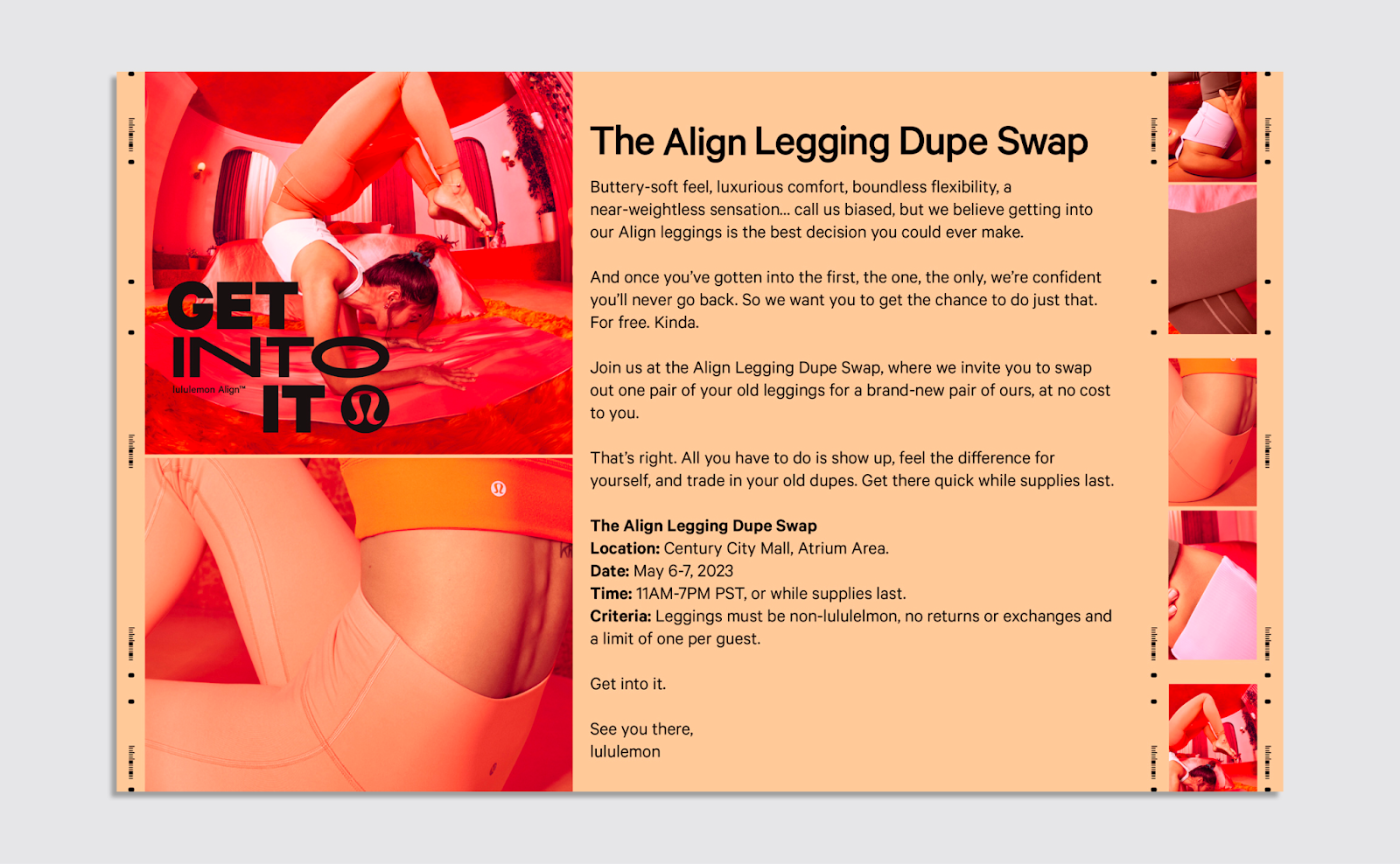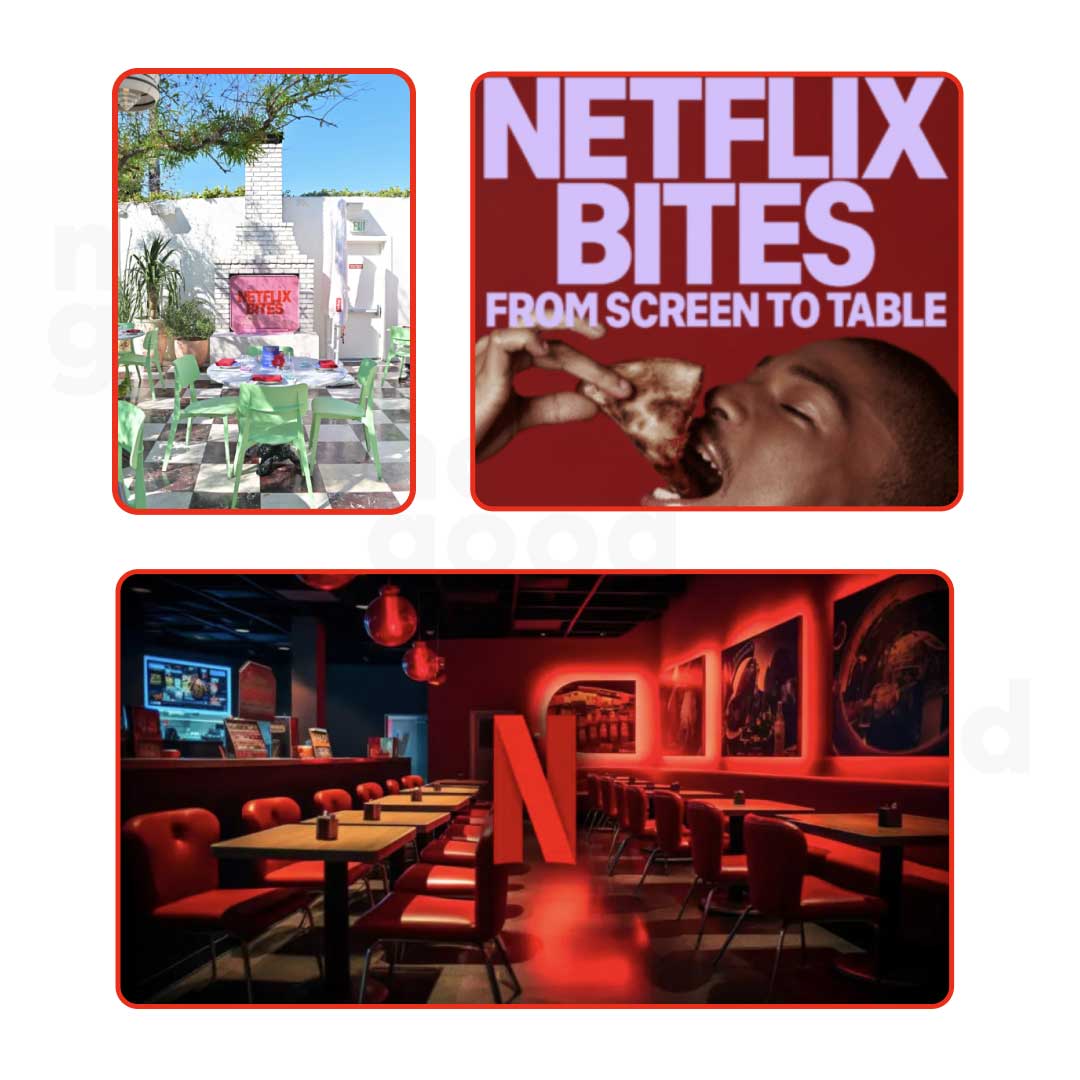In a world inundated with advertisements and digital noise, standing out from the crowd has become an increasingly challenging endeavor for brands, particularly since so many brand experiences are now digitally native and hence limited by a competitive attention economy.
Enter experiential marketing: an increasingly popularized marketing strategy that not only breaks through the clutter but emerges as a strategic powerhouse for building lasting and repeated brand loyalty. From Netflix’s brand-driven worlds to Lululemon’s innovative use of customer data, today’s successful brand empires are demonstrating the value of emotionally impactful consumer experiences in fostering community and generating long-term brand loyalty.
What is experiential marketing?
Experiential marketing, often referred to as engagement marketing, is a dynamic and immersive strategy that goes beyond traditional advertising or performance marketing. At its core, it’s about creating memorable, interactive experiences that forge a deep emotional connection between brands and their target audience. While brands are increasingly leaning on digital content for most if not all of their marketing efforts, experiential marketing provides a necessary counterbalance by focusing more on tangible, real-world interactions, fostering in-person engagement that transcends the limitations of screens and clicks.
Rather than reaching users through their one-way ad communications, experiential marketing invites consumers to be an active part of the brand’s story. It’s about crafting events, installations, or moments that captivate the senses, evoke emotions, and spark conversations — and consequently positive word-of-mouth. These experiences could be anything from pop-up stores, to interactive booths at events, to immersive product demonstrations.
By immersing existing and potential customers in an authentic brand encounter, experiential marketing transforms passive observers into enthusiastic participants, creating a sense of belonging and loyalty that’s hard to achieve through purely digital marketing channels. In essence, it’s a strategy that believes in creating moments, not just messages, and it’s a powerful tool in the arsenal of growth marketers seeking to build communities of loyal advocates.
What is the objective of experiential marketing?
The primary objective of experiential marketing is to forge an impactful and lasting connection between a brand and its target audience by creating positively memorable and actively interactive experiences. This approach transcends the superficial transactional relationship between the buyer and seller, aiming to cultivate strong emotional bonds that go beyond a one-time purchase.
Here are 6 key objectives of experiential marketing, beyond that of simply generating increased sales and revenue:
- Brand awareness and recognition: Experiential marketing aims to enhance a brand’s visibility by creating memorable, shareable experiences. These experiences can lead to increased brand recognition and the potential for organic word-of-mouth marketing, which is invaluable in a crowded marketplace.
- Building emotional connections: Beyond mere transactions, the objective is to build deep emotional ties with consumers. Experiential marketing leverages sensory elements, storytelling, and immersive experiences to create lasting positive associations that go beyond product features.
- Customer loyalty and advocacy: Experiential marketing aims to turn customers into loyal advocates. When consumers have a positive and memorable experience with a brand, they’re more likely to become repeat buyers, refer others, and even defend the brand in the face of competition.
- Product understanding and education: This objective focuses on providing consumers with a deeper understanding of a product or service by allowing them to experience its features and benefits in a real-world context. It’s a way to bridge the gap between what a product offers and what consumers perceive.
- Community building: Experiential marketing can help build a community of brand enthusiasts. By bringing people together around a shared experience, it fosters a sense of belonging and a strong community that supports the brand.
- Consumer research and data generation: Experiential marketing isn’t just about creating engaging events; it’s also a valuable tool in helping brands gather consumer data to better understand their target audience. During these interactive experiences, brands can structure the event in such a way that allows for data collection on consumer preferences, behavior, and sentiment, helping refine future marketing strategies.

The 6th objective of consumer research and data generation is a frequently overlooked objective of experiential marketing, particularly since so much of the strategy is led by prioritizing building emotional connections and fostering a sense of community. That being said, it’s a massive lost opportunity if brands are not actively building data collection and research into the structure of their experiential marketing strategies.
From event registrations and attendee demographics to engagement levels, dwell times, and even social media interactions generated during the event, experiential marketing offers a wealth of measurable data points.
Data tracking and user behavioral analysis can give brands insight into users’ digital interactions with the brand, but detailed, qualitative data is much more challenging to collect. Through interactive elements and direct interactions with consumers, brands can uncover first hand feedback and opinions about their products or services.
This first hand feedback is often more candid and insightful than traditional surveys. By observing how participants engage with specific aspects of an experience, brands can gain deeper insights into what resonates with their audience, helping to refine their messaging, product offerings, and overall marketing strategies.
For example, Lululemon’s “Dupe Swap” event was a brilliant example of how an immersive brand experience can also be leveraged as a data collection tool. The sportswear giant hosted a “Dupe Swap” experience where customers were encouraged to bring in their knockoffs of its incredibly popular Align pants to trade in for the original. While buying imitation products used to be something that’s looked down on, dupes have now become a style and trend all on their own.
The TikTok hashtag for #dupe now has 4.1 billion views, containing mostly videos of Gen Z creators showing off all the best dupes they’ve discovered. In response to this rise of dupe culture, Lululemon stepped into an ongoing cultural conversation in a creative way that clearly demonstrates the total confidence that they have in their cult-favorite product.

Not only did the event create a crucial sensory “aha” moment for the thousands of people that showed up to the 2-day event in Los Angeles, the brand also collected a stockpile of “dupes” that they can now use for product analysis and development. As dupe culture continues to evolve, Lululemon now has data from the event to better understand exactly what “dupes” consumers are buying, as well as the product qualities these “dupes” lack in comparison to Lululemon’s original product.
This data can aid Lululemon’s product and marketing teams in further refining their future releases to combat dupe culture and position themselves as the option-of-choice for their target audience.
What are the types of experiential marketing?
There are a variety of different types of experiential marketing, many of which can overlap to create multifaceted omnichannel events that may even include collaborations with other brands, creators or events. Here is a breakdown of the different types and structures of experiential marketing that brands can leverage:
1. Event-based experiences: These are immersive brand events, like the Lululemon dupe swap, designed to directly engage attendees and create lasting impressions. Whether it’s a product launch, a themed party, or a brand-sponsored festival, event-based experiences allow brands to directly engage with their audience in a controlled environment.
2. Immersive installations and pop-ups: Temporary physical spaces designed to immerse visitors in the brand’s world. These can be highly creative, utilizing art, technology, or unique environments to create a memorable experience and stimulate organic UGC.
3. Sponsorships and partnerships: Collaborating with other brands, influencers, or events can extend a brand’s reach and create a more significant impact by leveraging shared audiences.
4. Product sampling and demonstrations: Allowing consumers to try out products in real-world situations, either through free samples or live demonstrations, can help build trust and drive conversions. This type of experiential marketing is particularly suited for products that rely more on sensory experiences, such as food, bedsheets, or fragrances.
5. Interactive workshops and classes: Brands can offer hands-on workshops or educational classes related to their products or services. This not only showcases their expertise but also gives participants a chance to experience the value the brand provides. Classes are common in the health and fitness industry, where brands like Nike or Alo Yoga will host workout classes in a branded environment as a brand awareness and loyalty driver.
When deciding which type of experiential marketing to pursue, brands should consider the nature of their product or service, the typical behavior of their target market, and their primary and secondary marketing goals.
Begin by clarifying your objectives—do you want to boost brand awareness, drive sales, build customer loyalty, or launch a new product? It’s normal to have multiple objectives — experiential marketing can often help brands achieve multiple goals at once, but it’s important to identify which goals are a bigger priority and which are secondary objectives that can be relatively deprioritized. Goals should be ambitious but still realistic. Evaluate your available resources, both in terms of budget and manpower.
Some experiential marketing types, like large-scale events or immersive installations, may require substantial investments, while others, like online campaigns or guerrilla marketing, might be more budget-friendly.
Next, consider your target audience’s preferences and behaviors. Are they more likely to engage with physical events, do they prefer digital experiences, or are they drawn to cause-related initiatives? Understanding your audience’s preferences will help you tailor your approach.
Lastly, think about the synergy between different types of experiential marketing. Sometimes, a multifaceted approach that combines several types can create a more powerful impact. For example, a pop-up shop could be complemented by an interactive online campaign, extending your reach to both physical and digital audiences. The strategic key here is alignment. Choose the type of experiential marketing that aligns with your brand’s identity, resonates with your target audience, and can be executed effectively within your available resources.
What are the 11 pillars of experiential marketing?
Experiential marketing and the art of creating captivating brand experiences is built upon a solid foundation of 11 key pillars. These pillars are the guiding principles that shape successful experiential marketing campaigns. Let’s explore each pillar, unveiling the core elements that make experiential marketing an impactful and unique strategy for modern brands:
1. Exceptional: Experiences should be extraordinary, going beyond the mundane to create moments that stand out in the minds of participants. Creating in-person experiences typically requires a larger marketing budget than digital ads, meaning it’s more important than ever to make sure that the experience features innovative concepts, unexpected surprises, or remarkable creativity that leaves a lasting impression.
2. Shareable: Hosting an in-person event doesn’t mean that brand should ignore the digital element — in fact, experiential marketing can be a powerful omnichannel tool to encourage organic UGC and social sharing. Crafting experiences that participants want to share with their friends and followers expands the reach of your brand. Leverage the power of social media to amplify your message and engage a broader audience.
3. Memorable: Memory is the bridge that connects experiences to brand loyalty. By crafting memorable moments, you ensure that participants carry the essence of your brand with them long after the event has ended, reinforcing positive associations.
4. Relatable: Successful experiential marketing speaks directly to the topics and conversations that your target audience cares about, hence necessitating adequate market research beforehand to craft your event messaging to resonate with your ideal customer. Branded experiences should resonate with consumers’ values, interests, and aspirations, creating a sense of relatability that fosters genuine connection.
5. Relevant: Relevance is the key to capturing attention. Ensure that the experience aligns with the current needs and desires of your audience, and is culturally sensitive to demonstrating that your brand understands and caters to their preferences.
6. Personal: The human touch is priceless. Personalization adds a layer of authenticity and value, making participants feel seen and appreciated. Customized experiences create strong emotional bonds, boosting brand loyalty.
7. Targetable: Deep understanding of your audience is essential. By precisely targeting your experiential efforts to specific demographics, behaviors, and preferences, you maximize the impact of the experience. Leverage audience data and insights from experiments on other marketing channels to fine-tune your targeting, ensuring that you are reaching the right audiences with the right messaging.
8. Connectable: Forge connections that go beyond the event. Cultivate an ongoing relationship with participants, nurturing brand loyalty and advocacy. A connectable experience ensures that the brand remains part of their narrative. This can be done through post-event nurture flows, follow-up emails or even a continuation of the experience as a multi-part series. If the experience was a pop-up, let your attendees know where they can find you next after the pop-up ends.
9. Adaptable: The marketing landscape is dynamic, and adaptability is a must. Be ready to adjust to unforeseen circumstances, leveraging opportunities and addressing challenges without compromising the essence of the experience.
10. Engagement-Worthy: Active engagement is the currency of experiential marketing. Keep participants immersed, involved, and interactive. Engaged participants absorb the message, ensuring that it resonates deeply. Experiential marketing doesn’t have to be a big production — in fact over-curating an experience can alienate audiences into becoming passive watchers rather than active engagers. Don’t show, don’t tell; ask, communicate, and interact instead.
11. Credible: Trust is the foundation of any successful relationship, including the one between brands and consumers. Maintain authenticity, uphold your brand’s integrity, and deliver on promises to build and sustain credibility. It goes without saying that any promises that your brand makes during experiential marketing need to be upheld and followed-up on, thus demonstrating a sense of accountability towards your customers.

What are some examples of experiential marketing?
Successful brand experiences not only integrate the 11 pillars of experiential marketing, but they do so with a clear objective in mind that guides the strategic execution of the initiative.
Here are some best-in-class examples of experiential marketing initiatives:
1. Netflix Bites

Netflix took “immersive” to a whole new level with their “Netflix Bites” popup restaurant experience. The “screen to table” popup opened on June 30, 2023 in Los Angeles, and featured creations from chefs featured on shows available on the streaming service including “Chef’s Table,” “Iron Chef,” and “Drink Masters.” This is not Netflix’s first foray into in-person experiences — and it certainly won’t be their last. The streaming platform has already proven the success of their live experiences, such as The Queen’s Ball: A Bridgerton Experience and Stranger Things: The Experience.
These in-person experiences such as Netflix Bites provide a unique opportunity for viewers to engage with their favorite shows in a way that goes beyond just watching them on a screen. By creating additional touchpoints outside of the streaming platform itself, Netflix (and each of its shows) extends the reach of their brand and IP past the shelf life of any particular streaming season. When loyal fans attend these pop-up experiences, they create an organic content loop of UGC that is spurred from shareable experiences that fans will talk about long after the event has ended.
Netflix is definitely taking a page out of Disney’s playbook and making strides in creating a deeper sense of community beyond the screen. In a time where the streaming landscape is increasingly crowded and competitive, extending their brand beyond just the screen gives Netflix a competitive edge against their never-ending competition.
2. Barbie’s Airbnb Dreamhouse

It’s no secret that the Barbie movie knocked it out of the park on the marketing front, with over 100 brand collaborations and close to half a million articles being written about it. One of the most notable collaborations was the bookable ‘Barbie Dreamhouse’ experience hosted by Airbnb. Located in sunny Malibu, fans are invited to book their stay at the Dreamhouse and get the opportunity to live in technicolor for one night.
The experiential campaign’s shareability is evident as it capitalizes on the collective excitement surrounding the iconic characters, particularly as the brand geared up for the widely-anticipated movie release on July 21, 2023. The memorable nature of the experience is amplified by Ken’s twist, providing a fresh perspective on the cherished Dreamhouse. By revamping part of the DreamHouse according to Ken’s passions, the collaboration remains relevant, offering a unique take that resonates with modern audiences.
Targetability is at play as the campaign aligns with the release of the Barbie movie, ensuring a ready and excited audience. In creating an experience where guests can explore Ken’s wardrobe, dance floor, and outdoor activities, the campaign actively engages participants and encourages them to create shareable UGC for their own social media platforms.
The collaboration also strategically incorporates philanthropy in a way that authentically ties into the message of the movie, making a charitable contribution to Save the Children, an organization that provides learning resources and support to children, families, and communities in 100+ countries to build girls’ confidence and help them excel in school.
3. Roku City

Remember when everyone was talking about how they wanted to live in Roku city? Well, Roku made it happen. Roku brought the Roku City screensaver to life for a 2 day popup at SxSW 2023. The multi-level popup had everything from an indoor park to a rooftop diner with a menu inspired by popular TV shows and movies like Seinfeld and Inside Out.
This was a genius move on Roku’s part, because they’re basically capitalizing off of and leaning into the fact that Roku City has become a meme. Reportedly, Roku City is mentioned every 12 minutes on Twitter, and two in three Roku users said they would visit Roku City.
The Roku City SxSW popup serves as a valuable example of how experiential marketing can be leveraged to generate greater brand awareness, loyalty, and engagement. Firstly, it underscores the significance of capitalizing on hype. When a concept gains traction, seizing the moment and transforming it into a top-of-funnel awareness driver can yield greater results than more evergreen marketing efforts.
Secondly, the importance of data cannot be overstated. Understanding user behavior through data analysis enables informed decision-making. By tailoring experiential marketing strategies to align with user engagement patterns, brands can effectively cater to their audience’s preferences. In this case, Roku noticed the chatter surrounding their Roku City screensaver, and leveraged that cultural momentum to give their audience exactly what they want.
Lastly, the popup’s focus on community-building is a strategic move worth emulating. While the SxSW popup featured devices for sale, its core objective was not merely retail-based; it aimed at fostering brand awareness and cultivating a dedicated community of loyal customers. This approach establishes a lasting connection that drives repeated engagement.
The future is more than just the digital
As brands grapple with standing out and forming genuine connections in a digital era marked by virtual interactions, the appeal of tangible, memorable experiences make experiential marketing a key tactic in the future of modern marketing strategies. With the rise of technologies like AR and VR, the potential for even more engaging experiences is expanding, particularly omnichannel experiences that allow multiple different platforms and experiential formats to exist in synchronization with one another.
Consumer expectations and preferences are constantly changing, meaning that mastering experiential marketing will be a key differentiator for brands, enabling them to resonate with audiences, cultivate loyalty, and create a lasting impact. The road ahead for experiential marketing is marked by innovation, reshaping how brands connect, engage, and succeed in a consumer landscape of constant ebb and flow.







Amazing insight into omnichannel and experiential marketing. well explained.